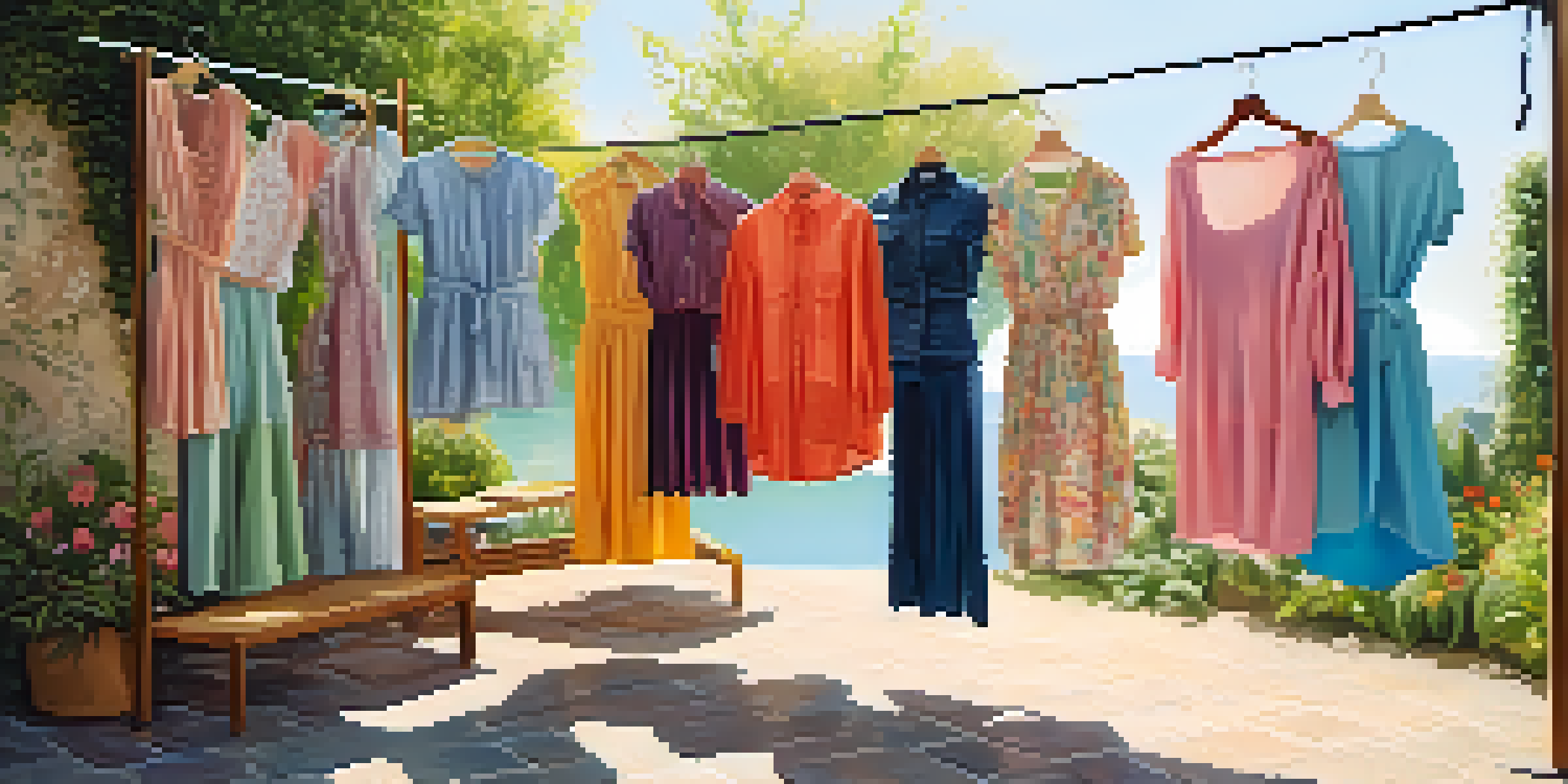Color and Gender: The Psychological Impact of Gendered Colors

Understanding Gendered Colors in Society
From the moment we enter this world, colors are often assigned based on gender. For example, pink is frequently associated with girls, while blue is seen as a color for boys. This societal norm influences how individuals perceive themselves and others, shaping their identities through color associations. Moreover, these color designs are prevalent in everything from toys to clothing, reinforcing the idea that certain colors are 'meant' for specific genders.
Colors are the smiles of nature.
Interestingly, these color associations are not universal. In some cultures, colors like red or yellow can signify different gender roles, showcasing the variability in color perception globally. This cultural aspect underlines that our understanding of gendered colors is not only rooted in tradition but also influenced by societal changes. As we continue to explore the psychology behind color, it's essential to consider these cultural dimensions.
Ultimately, understanding these gendered color norms can help us navigate their psychological impacts. By questioning why we assign certain colors to specific genders, we can begin to break down stereotypes and promote a more inclusive view of color. This awareness allows for a richer appreciation of color diversity and its potential to empower individual expression.
The Psychological Impact of Color on Gender Identity
Colors can evoke emotions and influence moods, and this effect is particularly pronounced when it comes to gender identity. For instance, studies have shown that individuals may feel more confident or comfortable wearing colors that align with their gender identity. This connection between color and self-perception highlights the psychological importance of color in our daily lives.

Furthermore, the pressure to conform to gendered color norms can lead to internal conflict for some individuals. Those who feel drawn to colors outside traditional gender associations might experience anxiety or self-doubt. This internal struggle underscores the broader psychological effects of societal expectations surrounding color and gender.
Color Associations Influence Identity
Societal norms assign colors based on gender, affecting how individuals perceive themselves and others.
By acknowledging these psychological impacts, we can foster more supportive environments that allow for diverse expressions of gender identity. Encouraging people to embrace colors that resonate with their true selves can promote mental well-being and self-acceptance. In this way, color becomes not just a visual choice but also a means of affirming one's identity.
Historical Context of Gendered Colors
The associations between colors and gender have evolved significantly over time. In the early 20th century, for instance, pink was considered a color for boys, while blue was deemed more suitable for girls. This reversal shows us how fluid color associations can be, shaped by cultural shifts and marketing strategies. Understanding this historical context helps us see that modern perceptions of color are not fixed but are subject to change.
The colors we choose to wear and surround ourselves with can transform our mood and self-perception.
Moreover, the commercialization of gendered colors began to take off post-World War II, when companies started targeting specific demographics to boost sales. As a result, the strong association of pink for girls and blue for boys became entrenched in Western culture. This commercialization has had lasting impacts on how children are socialized and how they view colors in relation to their identities.
Recognizing this historical backdrop provides a more comprehensive understanding of current color-gender dynamics. It reminds us that the colors we encounter daily are intertwined with societal constructs that influence our perceptions and experiences. By unpacking this history, we can better appreciate the ongoing evolution of color associations in relation to gender.
Color Preferences Across Genders: What Research Shows
Research into color preferences reveals intriguing patterns that vary by gender. Studies indicate that women often prefer softer, pastel shades, while men tend to gravitate toward bolder, darker colors. This trend may stem from societal conditioning from a young age, where children are frequently surrounded by gender-specific color palettes.
However, it's essential to recognize that these preferences are not absolute. Many individuals defy these trends, embracing a wide spectrum of colors regardless of gender norms. This variability suggests that personal experiences and cultural influences play a significant role in shaping color preferences, and that there's a growing movement towards color neutrality.
Historical Shifts in Color Norms
The associations between colors and gender have evolved over time, reflecting cultural shifts and marketing strategies.
By understanding these preferences, we can create more inclusive spaces that celebrate individual choices. Encouraging a broader acceptance of color preferences allows everyone to express themselves freely, regardless of gender. This shift can lead to a more vibrant society where color is seen as a personal choice rather than a gendered expectation.
The Role of Color in Marketing and Branding
In the world of marketing, color plays a crucial role in conveying messages and attracting target audiences. Brands often use gendered colors in their marketing strategies to appeal to specific demographics. For instance, beauty products aimed at women frequently utilize soft pinks and pastels, while tech gadgets for men might feature deeper tones like black or navy blue.
This strategic use of color can reinforce societal norms and influence consumer behavior. When consumers see a product in a color that aligns with their gender identity, they may feel more inclined to purchase it. However, this practice can also limit choices and perpetuate stereotypes about gender and preferences.
As the conversation around gender and color evolves, many brands are beginning to embrace more inclusive marketing strategies. By diversifying their color palettes and breaking away from traditional gender associations, companies can resonate with a broader audience. This shift not only reflects changing societal attitudes but also fosters a sense of belonging for consumers.
Challenging Color Norms: Embracing Inclusivity
Challenging traditional color norms is key to fostering inclusivity in our society. By encouraging individuals to embrace colors outside the conventional gender spectrum, we can promote a more accepting environment for everyone. This shift allows people to express themselves authentically, free from the constraints of societal expectations.
Many organizations and movements are already advocating for this change, pushing back against the idea that colors should be gendered. For example, gender-neutral fashion brands are gaining traction, offering clothing in a variety of colors that defy traditional classifications. These initiatives help dismantle stereotypes and create spaces where everyone feels valued.
Embracing Color Inclusivity
Challenging traditional color norms promotes a more accepting environment, allowing individuals to express their true selves.
Embracing this inclusivity not only enriches our understanding of color but also empowers individuals to express their true selves. As we continue to challenge and redefine these norms, we pave the way for a future where color is a celebration of diversity rather than a limitation. This shift can lead to greater acceptance and understanding across all gender identities.
The Future of Color and Gender Perceptions
As we look to the future, the perceptions of color and gender are likely to keep evolving. The rise of social media and global interconnectedness has facilitated the exchange of ideas and cultural values, leading to more fluid interpretations of color. As people become more aware of the impacts of gendered colors, we may see a growing rejection of outdated norms.
This transformation could result in a more vibrant palette that transcends traditional gender associations. Imagine a world where colors like teal, orange, or green are celebrated for their beauty, rather than being confined to specific gender categories. Such a shift would encourage individuals to explore their identities and express themselves without fear of judgment.

Ultimately, the future of color and gender perceptions is bright, as society continues to embrace diversity and individuality. By fostering open conversations and challenging stereotypes, we can create a world where everyone feels free to choose colors that resonate with their true selves. This journey toward inclusivity not only enhances personal expression but also enriches our collective experience.